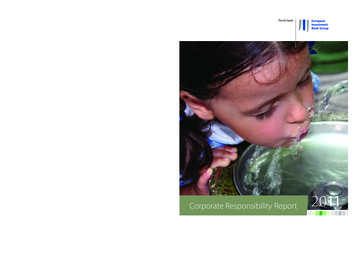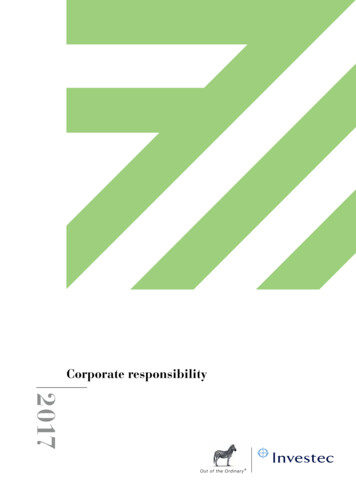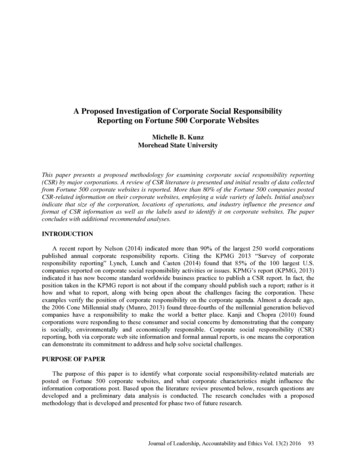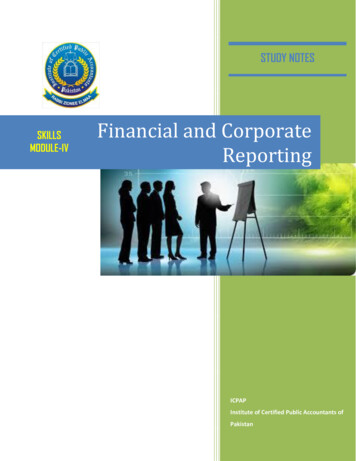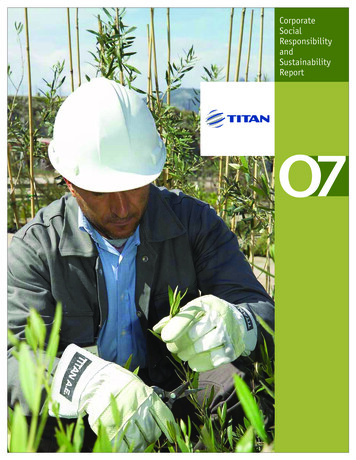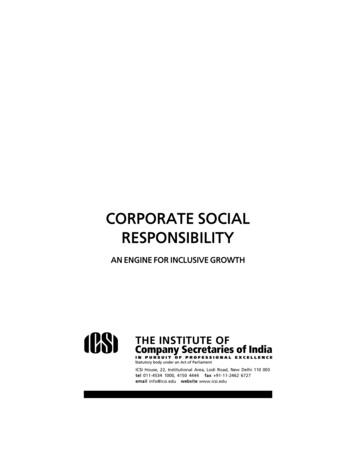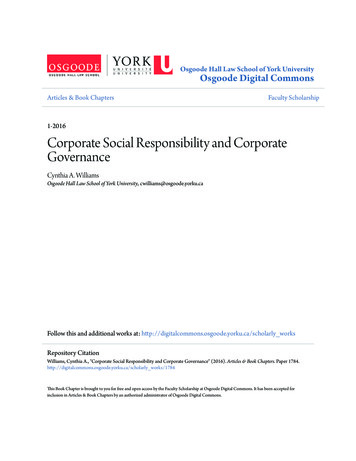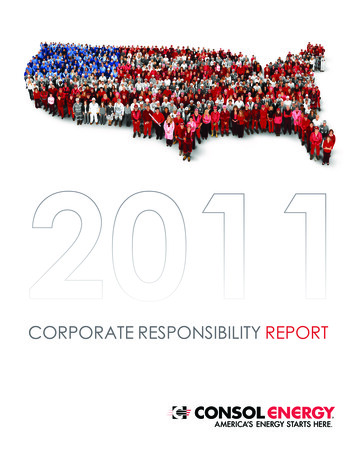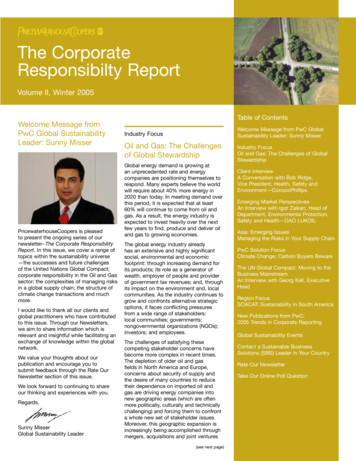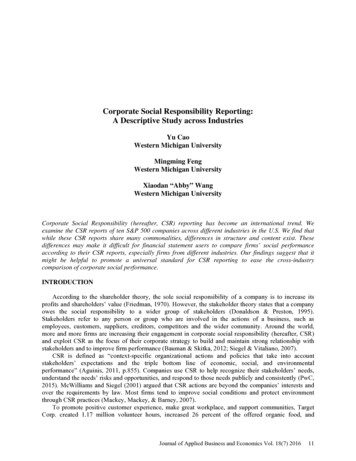
Transcription
Corporate Social Responsibility Reporting:A Descriptive Study across IndustriesYu CaoWestern Michigan UniversityMingming FengWestern Michigan UniversityXiaodan “Abby” WangWestern Michigan UniversityCorporate Social Responsibility (hereafter, CSR) reporting has become an international trend. Weexamine the CSR reports of ten S&P 500 companies across different industries in the U.S. We find thatwhile these CSR reports share many commonalities, differences in structure and content exist. Thesedifferences may make it difficult for financial statement users to compare firms’ social performanceaccording to their CSR reports, especially firms from different industries. Our findings suggest that itmight be helpful to promote a universal standard for CSR reporting to ease the cross-industrycomparison of corporate social performance.INTRODUCTIONAccording to the shareholder theory, the sole social responsibility of a company is to increase itsprofits and shareholders’ value (Friedman, 1970). However, the stakeholder theory states that a companyowes the social responsibility to a wider group of stakeholders (Donaldson & Preston, 1995).Stakeholders refer to any person or group who are involved in the actions of a business, such asemployees, customers, suppliers, creditors, competitors and the wider community. Around the world,more and more firms are increasing their engagement in corporate social responsibility (hereafter, CSR)and exploit CSR as the focus of their corporate strategy to build and maintain strong relationship withstakeholders and to improve firm performance (Bauman & Skitka, 2012; Siegel & Vitaliano, 2007).CSR is defined as “context-specific organizational actions and policies that take into accountstakeholders’ expectations and the triple bottom line of economic, social, and environmentalperformance” (Aguinis, 2011, p.855). Companies use CSR to help recognize their stakeholders’ needs,understand the needs’ risks and opportunities, and respond to those needs publicly and consistently (PwC,2015). McWilliams and Siegel (2001) argued that CSR actions are beyond the companies’ interests andover the requirements by law. Most firms tend to improve social conditions and protect environmentthrough CSR practices (Mackey, Mackey, & Barney, 2007).To promote positive customer experience, make great workplace, and support communities, TargetCorp. created 1.17 million volunteer hours, increased 26 percent of the offered organic food, andJournal of Applied Business and Economics Vol. 18(7) 201611
decreased 13 percent of water from year 2009 to 2014 (Target, 2015). Sony Corp. collects end-of-lifeproducts every year all over the world to maintain a sustainable environment for future generations. Inyear 2014, Sony Corp. collected approximately 23,853 tons of used consumer electronics through theTake Back Recycling Program. As of March 2015, Sony Corp. collected 158,128 tons of electronicsequipment scrap through the Recycling Program Website and 64 tons of used electronics through theGreen Glove Program (Sony Corporation, 2015).CSR reporting has become a global trend. Covering 4,100 firms across 41 countries, the 2013 KPMGSurvey of Corporate Responsibility Reporting suggested that the Americas has become the leading CSRreporting region (KPMG International, 2013). To report CSR practices, companies use different terms,such as CSR Report, Corporate Responsibility (CR) Report or Sustainability Report. As of year 2013, 76percent of companies from the Americas, 73 percent from Europe, and 71 percent from Asia Pacificreported their CSR activities. Besides, 93 percent of the largest 250 corporations in the world reportedtheir CSR activities (KPMG International, 2013). According to the Ernst & Young Value ofSustainability Reporting, 39 percent of U.S. companies reported their CSR activities compared to 61percent of companies from the rest of the world (EY, 2013).The objective of this study is to provide some descriptive evidence on CSR reporting practices acrossten industries in the United States (the U.S.). We examine the most recent CSR reports of ten S&P 500companies from different industries and identify their key similarities and differences. Industries aredefined as the first two digits of the Global Industry Classification Standard (GICS) codes (Standard &Poor’s Indices, 2008). The study continues as follows. We discuss the benefits and guidelines of CSRreporting, report our sample and methodology, present the empirical results of analysis and conclude.BENEFITS AND GUIDELINES OF CSR REPORTINGCSR reporting is an essential business management tool since CSR reporting “has become the defacto law for business, enhanced financial value, raised the bar on data integrity, and made the most ofassurance” (KPMG International, 2011, p.2-3; Boer, 2013). According to Bob Liodice (2010), theAssociation of National Advertisers’ president-CEO, ten firms have good CSR performance and businessperformance, such as Burt’s Bees that has natural personal care products and Whole Foods which suppliessustainable and organic food. These two examples show how CSR can connect to long-term businessstrategy. However, some companies do not care about CSR. For example, Walmart has been charged withdiscrimination, human rights violations, and environmental crimes (Troutman, 2015). Comcast’s mergermanner would result in monopolizing cable market (Troutman, 2015). These unethical actions causemany criticisms and damage companies’ reputation. Figure 1 shows that CSR reporting provides the mostvalue in five ways such that it improves corporate reputation, increases employee loyalty, reducesinaccurate information, helps companies refine their corporate vision or strategy, and increases consumerloyalty (EY, 2013).FIGURE 1TOP-FIVE WAYS THAT CSR REPORTING PROVIDE VALUEImproves ReputationIncreases Employee LoyaltyReduces Inaccurate InformationHelps the Organization Refine its Corporate Vision or Increases Customer Loyalty0102030405060Note: This figure shows the top-five ways that sustainability reporting provide value. This figure is adapted fromBoston College Center for Corporate Citizenship and EY 2013 Survey.12Journal of Applied Business and Economics Vol. 18(7) 2016
Although there is no formal laws or specific requirements, some guidelines are generally accepted forCSR reporting. Global Reporting Initiative (GRI) is a global independent organization that assistsbusinesses, governments and other organizations in recognizing and communicating the influence ofbusiness on critical sustainability issues such as climate change, human rights, corruption and others(GRI, 2016). The GRI Guidelines are the most popular framework around the world (GRI & ISO, 2014).These guidelines can be used by corporations of any size and any type for reporting on environmental,social and economic performance (GRI, 2016). Most organizations are currently using the G4 version ofthe GRI guidelines. As of year 2012, 78 percent of 4,100 companies and 82 percent of the world’s largest250 firms referred to the GRI Guidelines (KPMG International, 2013). For example, Target Corp. adoptedGRI G4 guideline as the standard for its 2014 CSR Reporting (Target, 2015).Furthermore, GRI and the International Organization for Standardization (ISO) published a report onhow to use the GRI G4 Guidelines and ISO 26000 in conjunction (GRI & ISO, 2014). ISO 26000: 2010 isa guidance on social responsibility. It can help clarify what social responsibility is, aid businesses andorganizations in transforming principles into effective actions, and share the best practices regardingsocial responsibility internationally (ISO, 2016).Other than the previous two standards, the Sustainability Accounting Standards Board (SASB) alsoprovided sustainability accounting standards, which are primarily used in the U.S. (SASB, 2013). As ofyear 2016, there exist sustainability accounting standards for 79 industries in 11 sectors” (SASB, 2016).SAMPLE AND METHODOLOGYIn this study, we compare the CSR reporting practices of exemplary companies from ten industries inthe U.S. based on the first two digits of the Global Industry Classification Standard (GICS) codes. TheGICS methodology has been commonly accepted as an industry analysis framework for investmentresearch, portfolio management and asset allocation (Standard & Poor’s Indices, 2008). The ten industrialsectors in the GICS classification system are: Energy, Materials, Industrials, Consumer Discretionary,Consumer Staples, Health Care, Financials, IT, Telecommunication Services, and Utilities. One samplecompany is chosen from each industrial sector based on the company’s reputation and the availability ofits CSR report as of December 31, 2015. Table 1 lists the company names and the GICS industrialsectors. All sample firms are S&P 500 companies.TABLE 1SAMPLE FIRMSCompany NameGICS Industrial SectorChevron Corp.Dow Chemical3MTargetP&GJohnson & JohnsonJPMorgan ChaseMicrosoftAT&T Inc.Duke EnergyEnergyMaterialsIndustrialsConsumer DiscretionaryConsumer StaplesHealth CareFinancialsInformation TechnologyTelecommunication servicesUtilitiesNote: This table lists the company names and GICS industrial sectors.First Two-digit of GICS10152025303540455055Journal of Applied Business and Economics Vol. 18(7) 201613
EMPIRICAL FINDINGSBy comparing their CSR reports, we identify key similarities and differences among the ten firmswith regard to a number of aspects, which are discussed as below.Letter from CEOAll of the ten CSR reports include a letter or statement from CEO or chairperson. These letters orstatements commonly highlight the company’s vision, discuss its attitude towards CSR, and summarizeits CSR efforts. For example, Microsoft’s CEO letter mentions business ambitions, innovativetechnology, brighter future, and CSR activities. Duke Energy’s CEO letter discusses the firm’s connectionto environment, safe operations, customers and communities, and business plans. Both letters helpshareholders better understand the CSR reports.GuidelinesNine out of ten companies use GRI guidelines. The only exception is Chevron Corp. Chevron Corpbelongs to the Energy sector and thus uses the IPIECA/API/OGP Index as its CSR reporting guideline,which is a specific reporting guidance for the oil and gas industry. Except for AT&T Inc., all of the othercompanies include a brief introduction of their guidelines of CSR reporting.HighlightsAll companies highlight their awards, recognitions and achievements of social responsibility involunteer time, donations, environmental sustainability, and diversity. For instance, in year 2013, AT&TInc. highlights its achievements in three main categories – people & communities, environment, andtechnology, such as more than 5.3 million volunteer hours and 130 million total giving (AT&T Inc.,2014). Moreover, 3M’s CSR report features six awards in year 2014, including ENERGY STARSustained Excellence Award, Dow Jones Sustainability Index, BUILDINGS Magazine Money SavingProducts, Edison Award, The World’s Most Ethical (WME) Companies, and Aon Hewitt’s 2014 TopCompany for Leaders (3M, 2015). Highlighting awards, recognitions and achievements of socialresponsibility is a simple and easy way to recognize a firm’s CSR efforts. Besides, all companies mentiontheir products to present the achievements on CSR activities. Microsoft provides students with free Office365 to support their education. Johnson & Johnson discusses the products that received Earthwardsrecognition of its CSR engagement in year 2014.ConcernsGRI index have three major categories - environment, society, and economy. There are a number ofcommon concerns across industries in each category.In the environment section, the ten CSR reports mainly focus on the efforts on water, waste, energy,climate change, supply of materials, and emissions. As shown in Table 2 Panel A, except for JPMorganChase, which is the only sample firm that does not involve in any physical production, all of the otherfirms mention water, souring materials and supplier as a concern.In the society section, all companies care about their employees, customers, and community. Toimprove employees’ loyalty and professional skills, most companies provide employees with greateducational opportunities and focus on diversity and inclusion. For example, Dow Chemical hiresemployees from different countries to create a diverse workplace. Johnson & Johnson leads a dynamicand growing business responsibility by offering more product options to improve suppliers’ diversity andinclusion. Other than caring about employees, companies also strive to satisfy customers with qualityproducts and services. Dow Chemical is responsible for customers’ health, safety, and privacy byfocusing on product stewardship. Furthermore, companies are willing to make social investments andencourage their employees to serve as volunteers in community. Chevron Corp. spent over 240 millionuniversally on social investment in year 2014 (Chevron Corporation, 2015). Target Corp. achieved their14Journal of Applied Business and Economics Vol. 18(7) 2016
goal of “maintaining one million volunteer hours annually, with total of 1,177,079 hours” in year 2014(Target, 2015, p.7).In the economy section, companies create many job opportunities for the society. In year 2014,Johnson & Johnson spent 3.7 billion on additions to property, plant and equipment, offering more jobopportunities (Johnson & Johnson, 2015). Most companies report company profile and corporategovernance clearly. For example, 3M mentions that the company profile helps stakeholders learn itsculture of innovation and how the company is “applying science to improve lives” (3M, 2015, p.125).Also, 3M “believes that good corporate governance practices serve the long-term interests ofstockholders, strengthen the management, and further enhance the public trust” (3M, 2015, p.131). 3M’scorporate governance is effective and efficient for its management and social supervision.Despite these common concerns, some sample firms also express firm-specific and/or industryspecific concerns (as shown in Table 2 Panel B). For example, JPMorgan Chase concerns aboutsupporting small businesses, expanding global financial capability, increasing economic competitiveness,and career mobility. Chevron concerns about the volume of petroleum spill. Dow concerns about valuingecosystems and corruption.In addition, there are some concerns in main categories that are not commonly shared among themajority of the sample firms (as shown in Table 2 Panel C). For example, in the environment section, twocompanies (P&G and Target) concern about packaging. In the society section, two companies (JPMorganand AT&T) concern about military and veterans. In the economy section, three companies (3M, Johnson& Johnson, and Target) concern about financial performance and summarize how to improve business intheir CSR reports.TABLE 2SIMILARITIES AND DIFFERENCES OF CONCERNS IN CSR REPORTINGPANEL A. CONCERNS IN MAJOR CATEGORIESConcernsCompanies Names (Number of Companies)Chevron, Dow, 3M, Target, P&G, JNJ, Microsoft,AT&T, Duke (9)WasteDow, P&G, JNJ, Microsoft, Duke (5)EnergyChevron, Dow, 3M, Target, P&G, Microsoft, AT&T,Duke (8)Climate ChangeChevron, Dow, P&G, JNJ, Duke (5)Sourcing Materials &Chevron, Dow, 3M, Target, P&G, JNJ, Microsoft,SupplierAT&T, Duke (9)EmissionsDow, 3M, Target, P&G, JNJ, Duke (6)Recyclability & RenewableDow, P&G, Microsoft, AT&T, Duke (5)Innovation & TechnologyJNJ, Target, 3M, Microsoft, AT&T (5)Health & SafetyChevron, Dow, 3M, P&G, JNJ, Microsoft, AT&T,Duke (8)Stakeholder EngagementChevron, Dow, Target, P&G, JNJ, Microsoft, Duke (7)Diversity & InclusionDow, Target, P&G, JNJ, JPMorgan Chase, Microsoft(6)Human RightsChevron, Dow, 3M, P&G, JNJ, Microsoft (6)CommunityDow, Target, JNJ, JPMorgan Chase, Microsoft,AT&T, Duke (7)PeopleChevron, Dow, 3M, Target, P&G, JPMorgan Chase,Microsoft, AT&T, Duke (9)Ethical, Integrity, Code ofDow, 3M, P&G, JNJ, Microsoft (5)conduct & ComplianceCategoriesEnvironment WaterSocietyJournal of Applied Business and Economics Vol. 18(7) 201615
EconomySocial Investment, CorporateGiving, Charitable Givingand PhilanthropyPolitical Contributions &Public PolicyHiring, Recruitment,Employment & Job CreationGovernanceProfileChevron, Duke, Target, JNJ, Microsoft (5)3M, JNJ, JPMorgan Chase, Microsoft, Duke (5)Chevron, Dow, 3M, JNJ, Chevron, AT&T (6)Dow, 3M, P&G, JNJ, JPMorgan, Microsoft, Duke (7)3M, P&G, JNJ, JPMorgan, Microsoft, Duke (6)Note: This table reports the concerns in the three major categories: environment, society and economy.CompanyChevron Corp.Dow ChemicalP&GPANEL B. DIFFERENT CONCERNS OF COMPANIESConcernsPetroleum Spill VolumeChemistryValuing EcosystemsCorruptionZero Manufacturing Waste to LandfillTruck TransportationPalm OilEliminating Research Involving AnimalsAdvertising and Promoting to Consumers AppropriatelyJohnson & JohnsonJPMorgan ChaseMicrosoftNotices of ViolationR&D and Clinical TrialsIngredientsLobbyingQuality & Safety of ProductsSupporting Small BusinessesExpanding Global Financial CapabilityIncreasing Economic CompetitivenessCareer MobilityHumanitarian and Disaster ResponseGlobal Network InitiativeDesign for Green DevicesProductivityAT&T Inc.Fleet (reached AFV goal halfway milestone)Duke EnergyCarbonSatisfaction Scores Improve; Rankings Still SluggishNew Natural Gas PipelineNuclear: Present and FutureAsh ManagementNote: This table reports the different concerns of companies.16Journal of Applied Business and Economics Vol. 18(7) 2016
PANEL C. DIFFERENT CONCERNS IN MAJOR CATEGORIESConcernsCompany Names(Number of Companies)BiodiversityChevron, Dow, JNJ (3)EnvironmentPackagingP&G, Target (2)ResourcesP&G, Duke (2)Hygiene & CleanP&G, Target (2)Military and VeteransJPMorgan, AT&T (2)SocietyTransparencyChevron, Target, JNJ, Duke (4)CultureDow, P&G, JPMorgan Chase, Microsoft (4)PartnershipsDow, 3M, Microsoft (3)Compensation3M, JNJ, Microsoft (3)Financial Summary & Performance 3M, JNJ, Target (3)EconomyCategoriesNote: This table reports the different concerns in the three major categories: environment, society and economy.Setting GoalsExcept for JPMorgan, all of the other companies set explicitly short-term goals, long-term goals orboth for sustainable development. Most companies report the progress toward achieving these goals.Chevron states it primary goal as “zero incidents” and describes the five operational excellenceobjectives: safety, health, environment, reliability and efficiency. However, besides these generaldescriptions of what it aims to achieve, Chevron does not provide specific action plan and timeline forthese goals. P&G focuses only on the long-term 2020 goal. Microsoft focuses only on the 2015 and 2016annual goals. All the other six companies describe both short-term goals and long-term goals and report ifthey exceeded, achieved, or are on track to achieve these goals in detail. For example, Dow states its 2015goal as “achieve at least three breakthroughs that will significantly help solve world challenges” (DowChemical, 2015, p.14). Dow also sets seven 2025 sustainability goals, aiming at magnifying its impactaround the world. Duke sets short-term and long-term goals in four aspects: customers, growth,operations, and employees. Target sets a mix of 20 short-term goals with different timelines ranging from2015 to 2017, with regard to environment, team member well-being, education, and volunteerism.Major IssuesTable 3 provides information on major issues discussed in these reports. One major issue that manyfirms face is globalization. Globalization provides new opportunities of benefiting from CSR efforts, butalso presents great challenges. Seven out of the ten sample firms either discuss their CSR activities at theglobal level or major global challenges they are going to deal with. For example, Johnson & Johnson andP&G report their CSR efforts on global medicals to promote global safety and health. Dow Chemicalreports several global conservation activities in its CSR report, such as “The Nature Conservancy/DowPilot #1 at Freeport, Texas, US” and “Habitat restoration at Mozzanica, Italy” (Dow Chemical, 2015,p.99).Journal of Applied Business and Economics Vol. 18(7) 201617
TABLE 3MAJOR ISSUES IN CSR REPORTINGCompanyChevron Corp.Dow Chemical3MSustainabilityNot mentioned.The Economic Impact ofSustainability; SustainableChemistry.Economic Sustainability;Sustainability Governance.TargetP&GSustainability EngagementEnvironmental Sustainability;Sustainable Forestry.Johnson &JohnsonJPMorgan ChaseCitizenship & SustainabilityMateriality Assessment ProcessSustainable FinanceMicrosoftEnvironmental Sustainability;Sustainable Manufacturing.ICT-based sustainability solutionsFinancial Stability (Sustainability)AT&T Inc.Duke EnergyGlobalizationGlobal Economic ImpactSelected Global Conservation ActivitiesGlobal Challenges;Globally Diverse Workforce;Global Code of Conduct; Public Policyand Engagement WorldwideNot mentioned.Worldwide Health, Safety andEnvironment Systems;Global Medical.Global HealthExpanding Global Financial Capability;Global Cities Exchange: 28 Cities in aLearning and Action Network.Global Network Initiative;Global Diversity and Inclusion.Not mentioned.Not mentioned.Note: This table provides information on the two common concepts (sustainability and globalization) discussed inthe CSR reports.While most sample firms commonly discuss the impact of globalization on their business and CSRinitiatives, only some firms discuss efficiency and affordability in their CSR reports. According to theMerriam-Webster’s Learner’s Dictionary (2016), efficiency is “the ability to do something or producesomething without wasting materials, time, or energy”. Affordability means “the extent to whichsomething is affordable, as measured by its cost relative to the amount that the purchaser is able to pay”(Your Dictionary, 2016). Although these two issues are closely relevant to CSR strategy, only threesample firms (Chevron Corp., Microsoft, and Duke Energy) mention energy efficiency, and two firms(Johnson & Johnson and Duke Energy) mention affordability in their CSR reports.Many people view CSR, CR, corporate citizenship and sustainability as interchangeable termsdescribing the same thing. However, sustainability is more like the end achieved by the means ofbehaving in socially responsible ways or being a good corporate citizen. While sustainability is a commontheme in CSR reporting, not every firm uses the term explicitly. In our sample, six firms use“sustainability” in the title of their CSR reports. Three firms use “responsibility” and two firms use“citizenship”. Except for Chevron, all other sample firms include discussions specifically on“sustainability” in their CSR reports.FormatTo effectively convey the information of their CSR efforts to stakeholders or the mass public, firmsneed present this information in appropriate ways and ensure the CSR report to be well formatted andeye-catching. All sample companies use reader-friendly figures and tables to clearly present key facts andstatistics. Except for Microsoft, all of the other firms use photos in their CSR reports. Some companies18Journal of Applied Business and Economics Vol. 18(7) 2016
use short articles to show their actions and opinions in details. For example, in the article “SIRTURO Research Team Wins European Inventor Award”, Johnson & Johnson summarizes its achievement inR&D and Clinical Trials field (Johnson & Johnson, 2015). Shareholders can learn P&G’s efforts in therenewable energy field from the article “Albany Plant to Receive 100% Renewable Steam from ScrapWood” (Procter & Gamble, 2015).In addition to the common elements such as figures, tables, photos, and short articles, somecompanies report their CSR practices in unique ways. For example, some companies summarize theirCSR efforts in specific cities or states. JPMorgan Chase reports its CSR activities in cities such as Detroitand Chicago. Duke Energy commits to the economic vitality of its community by states, such as NorthCarolina, South Carolina, Florida and so on (Duke Energy Corporation, 2015). Some companies includecritical conversations or Question and Answer (Q&A) section to respond to the most important CSRissues and show plans about CSR activities, such as JPMorgan Chase and Dow Chemical.LengthLast but not the least, there is no commonly acceptable standard length of CSR reports. The length ofour sample CSR reports ranges from 18 to 179 pages. As shown in Table 4, some companies’ CSRreports are comprehensive and lengthy, such as Dow and 3M (over 150 pages). Some are simple andshort, such as AT&T (only 18 pages). There are a number of potential explanations of the differences inCSR report length. Firms are exposed to high levels of public scrutiny and social pressure of behavingresponsibly might need to provide more information of their CSR practices in the report to satisfy thereaders. For example, since more and more people begin realizing the importance of environmentalprotection, companies in the Materials and Industrials sectors have attracted much public attention. DowChemical (in the Materials sector) increased the length of its CSR report from 94 pages in 2010 to 178pages in 2014. The diversity of stakeholders a firm deals with may also influence the amount ofinformation that needs to be included in the report. Johnson & Johnson (in the Health Care sector)provides considerable details in its CSR report since the company’s products are related to healthinessand penetrate people’s daily life, making almost everyone its stakeholders. In 2014 Citizenship &Sustainability Report, Johnson & Johnson describes its CSR efforts in advancing human health and wellbeing, leading a dynamic and growth business responsibility, and stewarding a healthy environment in122 pages.TABLE 4FREQUENCY, LENGTH AND GUIDELINES OF CSR REPORTING(as of December 31, 2015)CompanyChevron Corp.Dow Chemical3MTargetP&GJohnson &JohnsonJPMorgan ChaseMicrosoftAT&T Inc.Duke EnergyThe Most Recent CSR Report2014 Corporate Responsibility ReportHighlights2014 Annual Sustainability Report2015 Sustainability Report2014 Corporate Social ResponsibilityReport2015 Sustainability Full Report2014 Citizenship & Sustainability Report2014 Corporate Responsibility Report2015 Citizenship Report2013 Annual Sustainability Update2014 Sustainability ReportNumberGuidelinesof Pages30IPIECA/API/OGPIndex178GRI G4179GRI G474GRI G4Note: This table reports the length, frequency and guidelines of CSR reporting.75122GRI G3GRI G454711842GRI G3GRI G4GRI G4GRI G4Journal of Applied Business and Economics Vol. 18(7) 201619
Timeline and FrequencyAll ten companies update their CSR reports annually. Dow Chemical also updates its CSR reportquarterly. Different firms release their annual CSR reports at different times. Some firms provide theupdate in the end of the calendar year while some do so in the end of the financial year. Table 4 shows themost updated CSR reports of the sample firms when we initiated this study. As of December 31, 2015,3M, P&G, and Microsoft published 2015 CSR reports on their websites; some firms published their 2014CSR reports. Although AT&T Inc. has been updating its CSR efforts continuously on its corporatewebsite, its most recent formal CSR report was published in 2013.CONCLUSIONMore and more firms realize the importance of CSR reporting. The U.S. has become the leading CSRreporting region, followed by Europe and Asia Pacific. We examine the CSR reports of ten S&P 500companies across different industries in the U.S. While these CSR reports share many commonalities,differences in structure and content exist. These differences may make it difficult for financial statementusers to compare firms’ social performance by reading their CSR reports, especially firms from differentindustries. Therefore, it might be helpful to promote a universal standard for CSR reporting to ease thecross-industry comparison of corporate social performance.Even though CSR reporting is not mandated by law or the government, it becomes an internationaltrend. CSR reporting helps companies improve corporate reputation, increase employee and consumerloyalty, reduce inaccurate information, and increase efficiency and long-term profitability (EY, 2013).There may be a formal standard that is amplified, refined, organized and unified based on GRI guidelinein the future. Further, there have been some discussions on combining the CSR reports and financialstatements in an integrated manner. According to PwC (2013), stakeholders believe integrated reportingcan provide additional information to help achieve companies’ long-term prospects and help managersthink in an integrated way.While a firm’s financial performance is determined by a mix of contextual and strategic factors,effectively communicating with stakeholders on its social responsibility through annual CSR report maycontribute to its financial performance. Our study reveals how CSR reports of firms from differentindustries can differ. It may be worthwhile to explore if corpoarte financial performance is realted to thespecific way a firm drafts and organizes its CSR report. We suggest this as a pontetially fruitful directionof future research, which may further provides evidence if a universal standard of CSR reporting acrossindustries is necessary.REFERENCES3M. (2015). 2015 Sustainability Report. 3M.Aguinis, H. (2011). Organizational responsibility: doing good and doing well. APA Handbook ofIndustrial and Organizational Psychology, 855-879.AT&T Inc. (2014). 2013 Annual Sustainability Update.Bauman, C. W., & Skitka, L. J. (2012). Corporate social responsibility as a source of employeesatisfaction. Research in Organizational Behavior, 32, 63-86.Boer, Y. D. (2013). The KPMG Survey of Corporate responsibility reporting 2013: executive Summary.Retrieved ts/ArticlesPublic
Covering 4,100 firms across 41 countries, the 2013 KPMG Survey of Corporate Responsibility Reporting suggested that the Americas has become the leading CSR reporting region (KPMG International, 2013). To report CSR practices, companies use different terms, such as CSR Report, Corporate Resp
